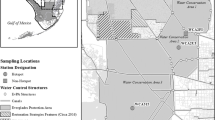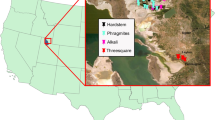Abstract
Legacy mercury (Hg) exists in Upper St. Lawrence River wetland hydric soils and is impacted by a new water level management plan (established in 2017) implemented to restore biodiversity and reduce the monotypic nature of riparian wetlands, currently dominated by Typha spp.. The distribution of Hg within the various components of a riparian wetland provides insight into potential impacts of water level fluctuations. Hydric soil represents 83% of the wetland Hg burden while wetland plant biomass contributed 17%, mostly due to organic detritus (13%). Although Typha roots had a bioconcentration factor of 1.2 (relative to hydric soils) and had the highest total Hg among living tissues (25 ± 9.3 ng/g dry wt.), detritus had the highest overall Hg content (110 ± 53 ng/g dry wt.). While root tissue Hg correlated significantly with soil Hg (p = 0.045), it was determined here that Typha spp. has limited use as a biomonitor in wetlands with low levels of Hg contamination, as in this ecosystem. Hg contained within the organic detritus contributed more to the overall Hg burden in these monotypic Typha wetlands than any other tissue or biomass component analyzed. Consequently, shifts in the plant community that are expected to result from a new water level management plan may alter Hg storage within these wetlands and affect its mobility in this ecosystem.



Similar content being viewed by others
Data Availability
The datasets generated and analyzed during the current study are available in the Mendeley Data repository, http://dx.doi.org/10.17632/4xtg543hdj.1
Code Availability
Not applicable.
References
Afrous A, Manshouri M, Liaghat A, Pazira E, Sedghi H (2011) Mercury and arsenic accumulation by three species of aquatic plants in Dezful. Iran Afr J Agric Res 6:5391–5397. https://doi.org/10.5897/AJAR10.818
Anning AK, Akoto R (2018) Assisted phytoremediation of heavy metal contaminated soil from a mined site with Typha latifolia and Chrysopogon zizanioides. Ecotoxicol Environ Saf 148:97–104. https://doi.org/10.1016/j.ecoenv.2017.10.014
Ashraf S, Ali Q, Zahir ZA, Ashraf S, Asghar N (2019) Phytoremediation: Environmentally sustainable way for reclamation of heavy metal polluted soils. Ecotoxicol Environ Saf 174:714–727. https://doi.org/10.1016/j.ecoenv.2019.02.068
Baker AJM, Brooks RR (1989) Terrestrial higher plants which hyperaccumulate metallic elements – a review of their distribution, ecology, and phytochemistry. Biorecovery 1:81–126. https://doi.org/10.1080/01904168109362867
Beauford W, Barber J, Barringer AR (1977) Uptake and distribution of mercury within higher plants. Physiol Plant 39:261–265. https://doi.org/10.1111/j.1399-3054.1977.tb01880.x
Beauvais-Fluck R, Slaeykova VI, Skyllberg U, Cosio C (2018) Molecular effects, speciation, and competition of inorganic and methyl mercury in the aquatic plant Elodea nuttallii. Environ Sci Technol 52:8876–8884. https://pubs.acs.org/doi/abs/10.1021/acs.est.8b02124
Bonanno G, Cirelli GL (2017) Comparative analysis of element concentrations and translocation in three wetland congener plants: Typha domingensis, Typha latifolia and Typha angustifolia. Ecotoxicol Environ Saf 143:92–101. https://doi.org/10.1016/j.ecoenv.2017.05.021
Brahmstedt ES, Zhou H, Eggleston EM, Holsen TM, Twiss MR (2019) Assessment of mercury mobilization potential in Upper St. Lawrence River riparian wetlands under new water level regulation management. J Great Lakes Res 45:735–741. https://doi.org/10.1016/j.jglr.2019.03.001
Carranza-Alvarez C, Alonso-Castro AJ, La Torre MCA, La Cruz RFG (2008) Accumulation and distribution of heavy metals in Scirpus americanus and Typha latifolia from an artificial lagoon in San Luis Potosi, Mexico. Water Air Soil Pollut 188:297–309. https://doi.org/10.1007/s11270-007-9545-3
Chen CY, Driscoll CT, Eagles-Smith CA, Eckley CS, Gay DA, Hsu-Kim H, Keane SE, Kirk JL, Mason RP, Obrist D, Selin H, Selin NE, Thompson MR (2018) A critical time for mercury science to inform global policy. Environ Sci Technol 52:9556–9561. https://doi.org/10.1021/acs.est.8b02286
Driscoll CT, Han Y, Chen CY, Evers DC, Lambert KF, Holsen TM, Kamman NC, Munson RK (2007) Mercury contamination in forest and freshwater ecosystems in the Northeastern United States. Bioscience 57:17–28. https://doi.org/10.1641/B570106
Esri Canada, Esri, Garmin, USGS, NGA, EPA, USDA, NPS, AAFC, NRCan, Maxar, Microsoft, Esri, GEBCO, DeLorme, NaturalVue, Esri, GEBCO, IHO-IOC GEBCO, DeLorme, NGS (2021)
Farrell JM, Murry BA, Leopold DJ, Halpern A, Rippke MB, Godwin KS (2010) Water-level regulation and coastal wetland vegetation in the upper St. Lawrence River: inferences from historical aerial imagery, seed banks, and Typha dynamics. Hydrobiologia 647:127–144. https://doi.org/10.1007/s10750-009-0035-z
Fay L, Gustin MS (2007) Investigation of mercury accumulation in cattails growing in constructed wetland mesocosms. Wetlands 27:1056–1065. https://doi.org/10.1672/0277-5212(2007)27[1056:IOMAIC]2.0.CO;2
Gomes M, de Souza R, Teles V, Mendes É (2014) Phytoremediation of water contaminated with mercury using Typa domingensis in constructed wetland. Chemosphere 103:228–233. https://doi.org/10.1016/j.chemosphere.2013.11.071
He M, Tian L, Braaten HFV, Wu Q, Luo J, Cai L, Meng J, Lin Y (2019) Mercury-organic matter interactions in soils and sediments: Angel or devil? B Environ Contam Tox 102:621–627. https://doi.org/10.1007/s00128-018-2523-1
International Joint Commission, (2016) Regulation Plan 2014 for the Lake Ontario and the St. Lawrence River. Washington, D.C. https://ijc.org/sites/default/files/201808/Plan2014_CompendiumReport_1.pdf. Accessed 20 April 2021
Krupp EM, Mestrot A, Wielgus J, Meharg AA, Feldmann J (2009) The molecular form of mercury in biota: identification of novel mercury peptide complexes in plants. Chem Commun 28:4257–4259. https://doi.org/10.1039/B823121D
Lominchar MA, Sierra MJ, Millan R (2015) Accumulation of mercury in Typha domingensis under field conditions. Chemosphere 119:994–999
Mahar A, Wang P, Ali A, Awasthi MK, Lahori AH, Wang Q, Li R, Zhang Z (2016) Challenges and opportunities in the phytoremediation of heavy metals contaminated soils: A review. Ecotoxicol Environ Saf 126:111–121. https://doi.org/10.1016/j.ecoenv.2015.12.023
Meng B, Feng X, Qui G, Wang D, Liang P, Li P, Shang L (2012) Inorganic mercury accumulation in rice (Oryza sativa L.). Environ Toxicol Chem 31:2093–2098. https://doi.org/10.1002/etc.1913
Meng M, Li B, Shao J, Wang T, He B, Shi J, Ye Z, Jiang G (2014) Accumulation of total mercury and methylmercury in rice plants collected from different mining areas in China. Environ Pollut 184:179–186. https://doi.org/10.1016/j.envpol.2013.08.030
Muthusaravanan S, Sizarajasekar N, Vivek JS, Paramasivan T, Naushad M, Prakashmaran J, Gayathri C, Al-Duaij OK (2018) Phytoremediation of heavy metals: mechanisms, methods and enhancements. Environ Chem Lett 16:1339–1359. https://doi.org/10.1007/s10311-018-0762-3
Olsen CI, Fakhraei H, Driscoll CT (2020) Mercury emissions, atmospheric concentrations, and wet deposition across the conterminous United States: Changes over 20 years of monitoring. Environ Sci Technol Lett 7:376–381. https://doi.org/10.1021/acs.estlett.0c00185
Panich-pat T, Srinives P, Kruatrachue M, Pokethitiyook P, Upatham S, Lanza GR (2005) Electron microscopic studies on localization of lead in organs of Typha angustifolia grown on contaminated soil. Sci Asia 31:49-53.
Patra M, Sharma A (2000) Mercury toxicity in plants. Bot Rev 66:379–422. https://doi.org/10.1007/BF02868923
Pirrone N, Cinnirella S, Feng X, Finkelman RB, Friedli HR, Leaner J, Mason R, Mukherjee AB, Stracher GB, Streets DG, Telmer K (2010) Global mercury emissions to the atmosphere from anthropogenic and natural sources. Atmos Chem Phys 10:5951–5964. https://doi.org/10.5194/acp-10-5951-2010
Risch MR, DeWild JF, Gay DA, Zhang L, Boyer EW, Krabbenhoft DP (2017) Atmospheric mercury deposition to forests in the eastern USA. Environ Pollut 228:8–18. https://doi.org/10.1016/j.envpol.2017.05.004
Song U, Waldman B, Park JS, Lee K, Park S, Lee EJ (2018) Improving the remediation capacity of a landfill leachate channel by selecting suitable macrophytes. J Hydro-Environ Res 20:31–37. https://doi.org/10.1016/j.jher.2018.04.005
Taylor GJ, Crowder AA (1983) Uptake and accumulation of heavy metals by Typha latifolia in wetlands of the Sudbury, Ontario region. Can J Bot 61:63–73. https://doi.org/10.1139/b83-005
Weis J, Weis P (2004) Metal uptake, transport and release by wetland plants: implications for phytoremediation and restoration. Environ Int 30:685–700. https://doi.org/10.1016/j.envint.2003.11.002
Wilcox DA, Ingram JW, Kowalski KP, Meeker JE, Carlson ML, Xie Y, Grabas GP, Holmes KL, Patterson NJ (2005) Evaluation of water level regulation influences on Lake Ontario and Upper St. Lawrence River coastal wetland plant communities: Final Project Report. I-64, Report to the International Joint Commission, Washington, DC and Ottawa, ON.
Wilcox DA, Kowalski KP, Hoare HL, Carlson ML, Morgan HN (2008) Cattail invasion of sedge/grass meadows in Lake Ontario: photointerpretation analysis of sixteen wetlands over five decades. J Great Lakes Res 34:301–323. https://doi.org/10.3394/0380-1330(2008)34[301:CIOGMI]2.0.CO;2
Willis JM, Gambrell RP, Hester MW (2010) Growth response and tissue accumulation trends of herbaceous wetland plant species exposed to elevated aqueous mercury levels. Int J Phytoremediat 12:586–598. https://doi.org/10.1080/15226510903390460
Ye ZH, Baker AJM, Wong MH, Willis AJ (1997) Zinc, lead and cadmium tolerance, uptake and accumulation by Typha latifolia. New Phytol 136:469–480
Acknowledgements
We thank New York State Parks for permission to conduct this study at Coles Creek State Park.
Funding
This research was supported by the Great Lakes Research Consortium (New York). Support for C.N.A.C. was provided by the National Science Foundation Research Experience for Undergraduates program (NSF Award No. 1659623 to M.R.T.).
Author information
Authors and Affiliations
Contributions
ESB was responsible for conceptualization, investigation, methodology, project administration, formal analysis, and writing the original draft. CNAC assisted with the investigation and methodology; TMH provided resources, and manuscript review & editing. MRT was involved with project conceptualization, funding acquisition, supervision, and manuscript review & editing. All authors read and approved the final manuscript.
Corresponding author
Ethics declarations
Conflicts of Interest/Competing Interests
The authors have no known personal or financial competing interests influencing this work.
Ethics Approval
Not applicable.
Consent to Participate
Not applicable.
Consent for Publication
Not applicable.
Additional information
Publisher's Note
Springer Nature remains neutral with regard to jurisdictional claims in published maps and institutional affiliations.
Rights and permissions
About this article
Cite this article
Brahmstedt, E.S., Crespo, C.N.A., Holsen, T.M. et al. Mercury distribution in an Upper St. Lawrence River wetland dominated by cattail (Typha angustifolia). Wetlands 41, 119 (2021). https://doi.org/10.1007/s13157-021-01511-9
Received:
Accepted:
Published:
DOI: https://doi.org/10.1007/s13157-021-01511-9




